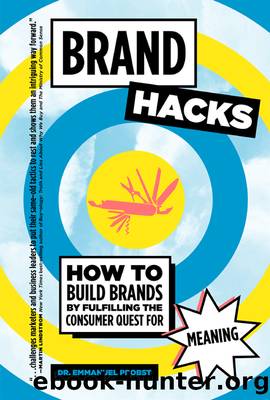Brand Hacks: How to Build Brands by Fulfilling the Consumer Quest for Meaning by Emmanuel Probst

Author:Emmanuel Probst [Probst, Emmanuel]
Language: eng
Format: epub
Tags: Business & Economics, Motivational, Consumer Behavior, economics, Theory
ISBN: 9781576878026
Google: fUsnEAAAQBAJ
Publisher: Simon and Schuster
Published: 2021-09-07T23:44:03.535915+00:00
SIDE HUSTLES
Today, 50 percent of millennials and 24 percent of boomers have a side hustle, whereby they have an additional income aside from their main jobs.10 Examples of side hustles include delivering food for Postmates, picking up rental electric scooters for Bird, and driving for Uber and Lyft. While some people take such side hustles out of necessity, for others side hustles fulfill a passion and contribute to a dream of success, prosperity, and even fame. For some, a side hustle means teaching yoga, being a freelance photographer or website designer. For others, side hustles are more entrepreneurial: starting a second-hand luxury clothes shop on eBay, baking wedding and birthday cakes, or even starting a food truck. Other side hustlers are driven by aspiration and dreams. These folks try to become a script writer, start their own line of products, or (you see it coming) become a social influencer.
Side hustles boost self-esteem: Hustlers feel fulfilled by doing something they like and can control, away from the daily grind of their regular jobs. Corporate America can be frustrating, riddled with hierarchies and office politics. Corporate jobs often feel rigid. Millennials, in particular, look for a spark and a sense of limitless possibility, both of which are often hard to find in a corporation. Getting promoted can take months, if not yearsâa timeframe that is not to the liking of a generation in constant pursuit of instant gratification.
Hustling on the side offers a sense of freedom without losing financial stability. Hustlers get to express their creativity, problem-solve, and learn new skills, which all become part of their core identity. For employers, hustlers can present a challenge when employees lose focus on their main job, show up in the morning late and exhausted because they spent half of the night designing a logo, or worse, run their side business during their work day.
We seek purpose
We often feel guilty about buying goods and services that we donât need. Therefore, we increasingly define ourselves not by what we have or want, but by what we believe in and the causes we champion. To counter guilt, we seek purpose by making a positive impact on the world around us. As consumers, we are getting tired of tacky advertising and gimmicky marketing tactics and aspire to buy products that reflect a positive attitude.
In The Purpose Economy: How Your Desire for Impact, Personal Growth and Community is Changing the World, Aaron Hurst defines purpose as âempowering people to have rich and fulfilling careers and lives by creating meaningful value for themselves and others.â11 He argues the âinformation economyâ is slowly being replaced by the purpose economy, whereby workers are driven by a higher mission, beyond producing wealth and being efficient and productive. Hurstâs ideas stem from management guru Peter Drucker, who long ago established the construct of âpurpose-driven business.â In Druckerâs view, companies needed a raison dâêtre, a higher mission to outlast competition.12
CASE STUDY: Patagonia
Patagonia embodies brand purpose, living by its mission statement of build the best products,
Download
This site does not store any files on its server. We only index and link to content provided by other sites. Please contact the content providers to delete copyright contents if any and email us, we'll remove relevant links or contents immediately.
Zero to IPO: Over $1 Trillion of Actionable Advice from the World's Most Successful Entrepreneurs by Frederic Kerrest(4075)
Machine Learning at Scale with H2O by Gregory Keys | David Whiting(3660)
Harry Potter and the Goblet Of Fire by J.K. Rowling(3619)
Never by Ken Follett(3549)
Ogilvy on Advertising by David Ogilvy(3351)
Shadow of Night by Deborah Harkness(3182)
The Man Who Died Twice by Richard Osman(2823)
Book of Life by Deborah Harkness(2726)
My Brilliant Friend by Elena Ferrante(2707)
How Proust Can Change Your Life by Alain De Botton(2620)
0041152001443424520 .pdf by Unknown(2608)
Will by Will Smith(2593)
The Tipping Point by Malcolm Gladwell(2566)
How to Pay Zero Taxes, 2018 by Jeff A. Schnepper(2505)
Purple Hibiscus by Chimamanda Ngozi Adichie(2503)
Hooked: A Dark, Contemporary Romance (Never After Series) by Emily McIntire(2428)
Rationality by Steven Pinker(2159)
Borders by unknow(2121)
Daughter of Smoke and Bone by Laini Taylor(2086)
